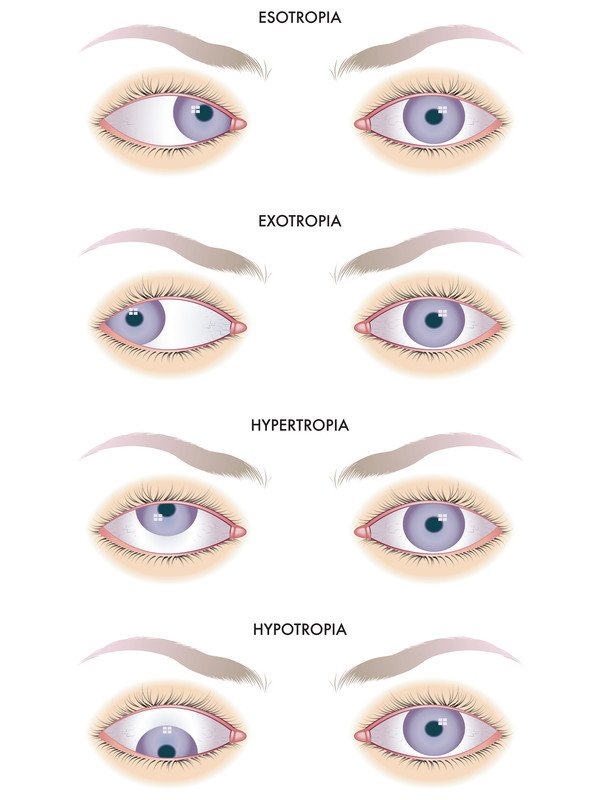What’s Strabismus?
Misaligned or crossed eyes is a condition medically known as strabismus and it’s more common than you might realize afflicting about 4% of the population. This disease usually presents in childhood and can lead to lazy eye, double vision or other visual problems that undermine your child’s learning and social development. The good news is that when diagnosed early strabismus can have a high treatment success rate. Pediatric ophthalmologists can detect Strabismus during a pediatric exam so it’s important to stay up on the recommended eye exam schedule.
Despite what your parents might have said to prevent you from misbehaving as a kid, your eyes will not stay crossed from making a funny face. Strabismus arises when there is an anatomical or neurological dysfunction which negatively impacts your extraocular muscles, the ones that control your eye movement.
12.4 MILLION AMERICANS
have had or currently have strabismus
When to See an Eye Doctor
Parents should be aware that strabismus often occurs in otherwise healthy children. The condition develops in babies and young kids – often by age 3 – although older children and even adults can have it. There may be a genetic component to strabismus making the child of a parent with the condition more likely to have it. Certain disorders that affect brain function like hydrocephalus or cerebral palsy can make developing strabismus a greater possibility. Occasionally, a child with uncorrected farsightedness will develop accommodative esotropia which occurs when the child uses excessive effort to focus their eyes to compensate for poor sight. Usually, the condition presents before age 2, but onset later in childhood is possible. Unlike other types of strabismus, prescription lenses can possibly correct accommodative esotropia.
Signs and Symptoms of Strabismus
The primary sign of strabismus is noticeable eye misalignment, where the eyes are not working as a team and one eye turns out, in, down or up. During early vision development, newborns may have intermittent eye misalignment. Infants should outgrow this as their eyes and brains mature. By about 4 months, infants’ eyes should be working in tandem and eye crossing or misalignment should no longer be present.
A couple of essential facts about strabismus:
- Beyond the first few months of life, eye misalignment and crossing are not normal.
- Contrary to popular misconception, a child will not outgrow it on their own.
- An eye doctor should examine a child who displays signs of strabismus right away. A pediatric eye exam is the surest way to receive an accurate diagnosis and a treatment plan with a successful outcome.
Different Types of Strabismus
Your 6 extraocular muscles work with adjacent nerves and your brain to coordinate movement in both eyes. The brain sends signals via the nerves to the muscles to direct their motion and the muscles direct the eyes to focus on the same point at the same time. If this interplay between muscles and functions is off, the eyes may not maintain proper alignment or work together as they should. Strabismus interrupts the type of vision that uses both eyes’ overlapping fields of view to create one, clear picture.
Strabismus may cause the eye to turn:
- Outward (exotropia)
- Inward (esotropia)
- Downward (hypotropia)
- Upward (hypertropia)

Strabismus can be further classified by:
- Its frequency – whether it is constant or intermittent.
- The number of eyes affected – if it is one eye (unilateral) or both (alternating).
- The degree of misalignment – significant and obvious misalignment is called large-angle, while less noticeable is called small-angle.
Importance of Early Treatment
Delayed treatment for strabismus can lead to the condition worsening, or to related vision problem, such as:
- Double vision– the simultaneous perception of two images, usually overlapping, of a single scene or object. This can happen in people with misaligned eyes since the brain is receiving different images from each eye to process.
- Amblyopia – better known as lazy eye, this is when vision in one eye is weaker than the other eye. In strabismus patients, this can happen over time as the brain ignores visual input from the misaligned eye. Patients with large-angle strabismus are at greater risk of developing lazy eye.
- Other symptoms, more common in small-angle and alternating strabismus patients, are headaches, eye strain, unstable vision and difficulty reading (due to eye fatigue).
Besides inducing physical side-effects and vision impairments, strabismus can be damaging to a child’s self-esteem. Past a certain age, a child with strabismus will be aware of their abnormal eye alignment. Strabismus can make normal eye contact with other people difficult creating more obstacles to positive social interaction.
Treatments for Strabismus
Strabismus treatment seeks to improve eye alignment and binocular vision. Some patients, especially with small-angle or alternating strabismus, may benefit from eyeglasses. The earlier doctors detect strabismus and treat it, the greater the chances of correcting it with non-surgical options.
The most effective form of treatment is surgery, particularly for large-angle or constant strabismus patients. The surgery involves loosening or tightening the extraocular eye muscles to alter the alignment of the eyes. Strabismus surgery can effectively align the eyes in children. In patients who have had long-standing strabismus significant weakness in one eye may remain despite lazy eye treatment and strabismus surgery. This is yet another reason why regular eye exams with a pediatric ophthalmologist or optometrist are so important.
3 Questions to Ask Your Eye Doctor Before Surgery
Surgery – especially involving our children – can be a nerve-wracking experience. Below are a few questions to ask your surgeon, so that you feel better prepared before your child goes in for the procedure.
- Ask your eye surgeon about their success rates in treating your child’s type of strabismus.
- Find out what criteria are used to label a treatment a success. “Success” for one practitioner may be reducing the eye turn for better alignment. Another surgeon may only call a “success” eye that have achieved perfect alignment and normal depth perception and vision.
- Ask if one surgery will be enough, or if additional operations are likely to be needed.
A reputable pediatric ophthalmologist can answer these and other concerns you may have about treating your child’s strabismus. Of course, we all want what is best for our kids so finding the right doctor to diagnose and treat strabismus is another way of giving our kids the best shot for a happy and healthy future.
Contact SightMD today to schedule an appointment with one of our doctors to discuss your child’s vision health at one of our convenient locations!

Bad Habits To Avoid When Using Contact Lens That Can Endanger Your Eyes
Contact lenses can change your world. While many people prefer the look and ease of glasses, others enjoy the freedom…

Are my reading glasses making my eyes worse?
Short answer- No Although we don’t know the exact mechanism by which humans have a decreased ability to focus…

Dos and Don’ts for Contact Lens Wearers
Contact Lenses & Eye Care Contact lenses are a safe and convenient way to correct your vision — as…